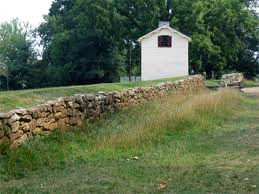Tuesday, December 4, 2012
Battle of Harper's Ferry
When Lee learned that the garrison at Harpers Ferry had not retreated after his incursion into Maryland, he decided to surround the force and capture it. On September 15, Union commander Col. Miles surrendered the garrison of more than 12,000. Jackson took possession of Harpers Ferry, then led most of his soldiers to join with Lee at Sharpsburg.
This is a present day picture of Schoolhouse Ridge from the battle of Harper's Ferry.
This illustration shows the U.S. Marines attacking John Brown's fort.
John Brown was hung as a result of his trying to take Harper's Ferry, his raid and destrution.
Monday, December 3, 2012
Battle of Chatanooga
Union forces under General Grant defat the seige army of General Bragg. The Union troops avenge their defeat at Chickamauga by going to Missionary Ridge without orders and carrying the seemingly firm Confederate postion.
This photo captures Federal troops camped in Chatanooga after the battle.
Confederate General Braxton Bragg defeated by Union forces.
These are Sutler's shops that sprang up in Chattanooga after the battle.
Battle of Chickamauga
A Confederate victory by General Braxton Bragg leaves General William S. Rosecran's Union Army trapped in Chattanooga, Tennessee, under Confederate seige.
General Patrick R. Cleburne and his staff pressed forward during the battle to distribute amunition to his men.
This ia a sketch of the caissons and dead horses after the battle.
Johnny Clem, "The Drummer Boy of Chickamauga", was the twelve-year-old drummer of the 22nd Michigan Infantry who shot the Confederate colonel, and proceeded back to the Union lines.
Battle of Gettysburg
On July 1, 1863, Confederate forces drove Union defenders to Cemetary Hill. The next day there was fighting at Little Round Top, Devil's Den, Peach Orchard, the Wheatfield, East Cemetary Hill, and Culp's Hill. On July 3, Robert E. Lee attacked the Union on Cemetary Ridge which ended in heavy losses and is now known as Pickett's Charge. Lee's second Northern invasion failed.
This statue of Union General John Reynolds marks the place where he was mortally wounded on the Gettysburg Battlefield.
Around 3,200 Union soldiers and 4,700 Confederate soldiers were killed during this bloody battle at Gettysburg.
The battle of Gettysburg, July 1-3, 1863, resulted in a Union victory and was considered the turning point of the Civil War.
Battle of Chancellorsville
The Union army under General Hooker is defeated by Robert E. Lee's forces as a result of Lee's brilliant and daring tactics.
This illustration shows the collapse of the Union Eleventh Corps as a result of Jackson's Flank Attack.
This painting by Don Troiani shows the Confederate attackers coming out of the forest to attack the right flank of the Union XI Corps on May 2, 1863.
This monument, dedicated in 1888, was placed where Stonewall Jackson was mortally wounded.
Battle of Fredricksburg
Union engineers laid five pontoon bridges across the Rappahannok on December 11, 1862. The next day, the Federal army crossed over and on December 13, Burnside led assults on Prospect Hill and Marye's Heights. On December 15, Burnside recrossed the river after calling off the offensive, ending the campaign.
This tablet at the site of the Middle Pontoon Bridge commemorates the service of the Irish Brigade who suffered severe losses during the assult at Marye's Heights.
This is a photo of the Innis House which was one of the few houses that stood along the side of the Sunken Road during the battle. This is the only one of these houses still standing today.
The home of John Marye, known as the Brompton, had Confederate artillery around it, making it a hot spot during the battle for the Sunken Road.
Battle of Antietam
Th Army of the Potomac under George McClellan assulted Robert E. Lee's forces. McClellan's army was pushed back again. This was the single bloodiest day in American history and the retreat of the Confederates gave President Lincoln the victory he needed before issuing the Emancipation Proclamation.
This picture is of the dead Confederat soldiers before the Dunker Church on the Antietam Battlefield.
This is a picture showing the thousands of dead sodiers in Bloody Lane at Antietam.
This photo captures President Lincoln, George McClellan, and other Union officers near the Stephen P. Grove farm.
Battle of Shiloh
The Confederate soldiers under command of General Albert Sidney Johnston made a surprise attack on the Union soldiers under Ulysses S. Grant. The second day of the battle, the Union overpowered the weakened Confederates who then retired from the field.
This is only one of the five Confederate burial trenches on the battle ground.
These are the survivors of the Battle of Shiloh taken around 1900.
The Shiloh National Military Cemetary holds more than 3,500 Union graves.
First Battle of Bull Run (Manassas)
The Union Army suffers a defeat and falls back to Washington. This is where Confederate General Thomas Jackson earns the name "Stonewall".
This picture shows Ambrose Burnside leading an attack during the battle.
This wartime sketch shows the Henry House and the damage it received during Bull Run.
This is showing the Stonewall Jackson Monument at the Manassas Battlefield.
Battle of Fort Sumter
On April 12, 1861, the Conferderates under General Beauregard fired upon the Union Army. The Union general, Major Robert Anderson, surrendered the next day.
This is Confederate general P.G.T. Beauregard.
This is a picture showing the Confederates firing on Fort Sumter.
This picture shows Fort Sumter under attack.
Subscribe to:
Posts (Atom)





























